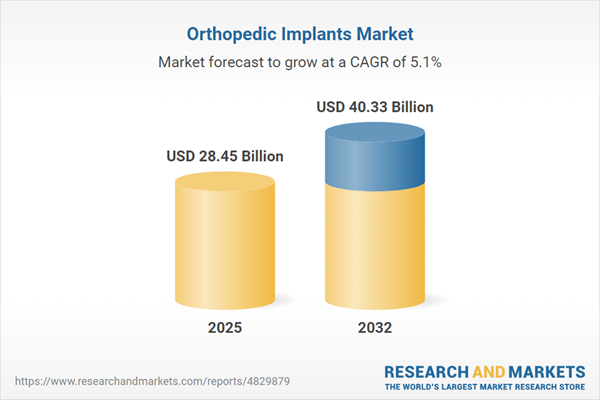Speak directly to the analyst to clarify any post sales queries you may have.
The orthopedic implants market is rapidly adapting as healthcare providers embrace advanced technologies and respond to changing clinical demands. With modernization at the forefront, informed leadership is essential for navigating this evolving landscape.
Market Snapshot: Orthopedic Implants Market Size and Growth
In 2024, the global orthopedic implants market is valued at USD 27.14 billion and is expected to reach USD 40.33 billion by 2032, reflecting a CAGR of 5.07%. This growth is fueled by demographic changes, notably an aging global population, and the wider use of orthopedic interventions. Rising adoption of minimally invasive procedures and continuous digital innovation are streamlining patient outcomes. Leading manufacturers are adjusting their product strategies and portfolios to stay current with changing regulatory requirements and evolving healthcare standards. The orthopedic implants market remains a critical focus for organizations prioritizing data-driven decisions and long-term growth.
Scope & Segmentation of the Orthopedic Implants Ecosystem
This report provides a practical framework for executives to assess opportunities and risks within the orthopedic implants sector, highlighting areas for investment, operational optimization, and competitive planning.
- Product Types: Market offerings include ankle, dental, elbow, hip, knee, shoulder, spinal, and wrist implants, supporting various medical indications in acute and chronic care settings.
- Material Types: Alumina, zirconia, cobalt-chromium alloys, stainless steel, titanium alloys, polyethylene, PMMA, and silicone are core materials, chosen for their durability, biocompatibility, and impact on procurement strategy and engineering requirements.
- Applications: These implants enable procedures in fracture management, spine and dental surgery, trauma, congenital correction, oncology, and sports medicine. Their use reflects increased adoption in both established and emerging healthcare markets.
- End Users: Hospitals, ambulatory surgery centers, specialty clinics, and research organizations drive device demand and influence key acquisition decisions.
- Distribution Channels: Companies leverage traditional distribution alongside digital platforms, enhancing supply chain responsiveness and broadening market access across global regions.
- Geographic Coverage: The report analyzes America, Europe, Asia-Pacific, and the Middle East & Africa, each presenting unique regulatory, operational, and partnership opportunities essential for strategic expansion.
- Featured Companies: Leading firms such as B. Braun SE, Medtronic PLC, Amplitude SAS, Stryker Corporation, and Zimmer Biomet Holdings, Inc. are central to industry collaboration and technological progress.
Key Takeaways for Orthopedic Device Decision-Makers
- Additive manufacturing is supporting on-demand, patient-specific implant solutions, streamlining design and production cycles.
- Adoption of digital health and remote monitoring technologies is optimizing the continuum of care, driving improvements in clinical workflows.
- Cross-sector collaboration between manufacturers, technology developers, and material suppliers is improving response to emerging regulatory trends and clinical requirements in the orthopedic device market.
- Growth in minimally invasive surgical techniques is significantly improving operational efficiency and reducing patient recovery times, driving more efficient use of healthcare resources.
- Stricter regulatory scrutiny is leading organizations to strengthen compliance infrastructure, mitigate risk, and protect brand reputation, while creating opportunities for process enhancements.
Tariff Impact: Navigating 2025 U.S. Policy Shifts
Emerging U.S. tariffs on orthopedic implants and related components are prompting producers to reexamine global supply and manufacturing strategies. To maintain compliance, many are integrating advanced alloys and bioresorbable materials, as well as seeking closer collaboration with suppliers and regulatory bodies. These changes are driving greater agility and helping organizations adapt proactively to evolving policy environments.
Methodology & Data Sources
Findings are based on structured interviews with surgeons, procurement professionals, and regulatory specialists, bolstered by peer-reviewed research, global filings, and patent analysis. This comprehensive approach ensures senior leaders access actionable insights for both strategic and operational challenges in the orthopedic device industry.
Why This Report Matters for Orthopedic Device Leaders
- Benchmark innovation and growth strategies with up-to-date intelligence to guide market positioning amid technological advancement.
- Access tools for managing operational, compliance, and supply chain risks, supporting sustained adaptability and competitiveness.
- Identify priorities for digital transformation and process improvement to drive efficiency and long-term sustainability.
Conclusion
This analysis supports executive decision-making by delivering evidence-based insights that help optimize operational strategies and reinforce leadership in a dynamic orthopedic implants market.
Additional Product Information:
- Purchase of this report includes 1 year online access with quarterly updates.
- This report can be updated on request. Please contact our Customer Experience team using the Ask a Question widget on our website.
Table of Contents
3. Executive Summary
4. Market Overview
7. Cumulative Impact of Artificial Intelligence 2025
List of Figures
Companies Mentioned
The companies profiled in this Orthopedic Implants market report include:- B. Braun SE
- Amplitude SAS
- Medtronic PLC
- Argomedical AG
- Biotech GmbH
- Biotechni
- Ceraver
- ConforMIS, Inc.
- CONMED Corporation
- Corin Group PLC
- DePuy Synthes, Inc. by Johnson & Johnson Services Inc.
- Enovis Corporation
- Exactech, Inc.
- GWS Surgicals LLP
- Hipokrat A.S
- Implants International Ltd
- MicroPort Scientific Corporation
- Orthofix Medical Inc.
- Peter Brehm GmbH
- Smith & Nephew PLC
- Stryker Corporation
- X. NOV Group
- Zimmer Biomet Holdings, Inc.
Table Information
| Report Attribute | Details |
|---|---|
| No. of Pages | 185 |
| Published | November 2025 |
| Forecast Period | 2025 - 2032 |
| Estimated Market Value ( USD | $ 28.45 Billion |
| Forecasted Market Value ( USD | $ 40.33 Billion |
| Compound Annual Growth Rate | 5.0% |
| Regions Covered | Global |
| No. of Companies Mentioned | 24 |









